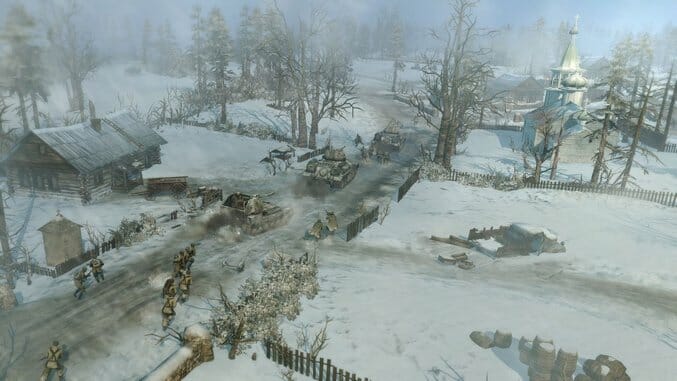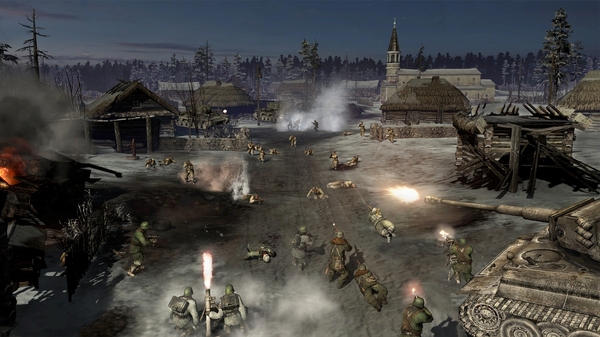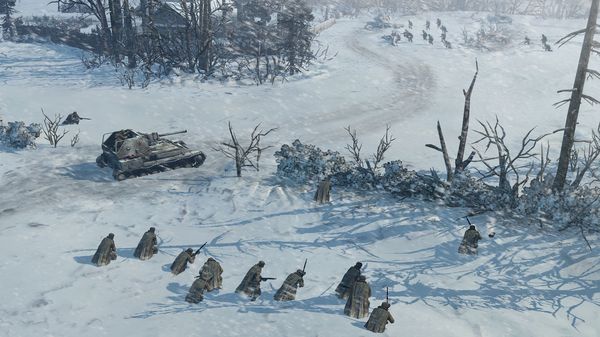
Since the release of the first Company of Heroes in 2006, World War II games have fallen out of vogue. Actually, since Spielberg lost interest post-Pacific, World War II media has taken an apparent backseat to modern warfare. The Call of Duty: Modern Warfare series and films like Zero Dark Thirty have ushered in a relative drought of historical non-fiction fiction (like Band of Brothers, Saving Private Ryan or Big).
Between 2006 and today, game development tools have become exponentially more sophisticated (the Essence 3.0 engine, in this instance). Naturally, the arms race for photorealistic modern warfare simulation superiority has followed close behind, leaving just a few development teams to refine the craft of telling World War II stories.
Relic Entertainment, however, is a game development team based in Canada. The vogue-shift raven hasn’t reached them yet, so they made another WWII game, borrowing heavily from the first iteration in form and function. Company of Heroes 2 feels like a moment from 2004’s military history zeitgeist (three words I resolve to never place end to end again), and not only because it’s one of a sparing few games still tonally driven by tales of the courage of the common Allied non-com in WWII, but because it’s a WWII real time strategy game. That is, it’s a game about the value of the soldier in which the soldier is also little more than an expendable tool. Maybe that’s the point.
There’s an uncomfortable tension between the logical imposition of a real-time strategy game and storytelling, the kind that asks a Soviet hive-mind to consider the life of the individual, or that plays Rock, Paper, Scissors with America’s villains from the sixties. Relic Entertainment must think I’m one of those benevolent despots, ruling my military citizenry with merciful justice. But then again, they must also think I’m a guy playing a sequel to the highest rated PC strategy game of the last seven years. And I’m just a hive-mind, for Stalin’s sake!
Company of Heroes 2 casts me in the role of a nameless Soviet or Nazi overlord with the ability to control any unit of the same nationality as they battle through the harsh winters of the early war on the Eastern Front all the way to the top of a crumbling Reichstag at the close of the European Theater. As with any RTS, my power is absolute, and terrifying. “Run directly into that artillery barrage, comrade!” I find myself yelling at my computer screen. “For the motherland!” it yells back.
Of its three modes, the campaign is clearly the battleground for a long, bloody conflict between the game designers and the game writers, one of whom is history. The ten-hour journey follows Lev Isakovich in the flashback style of The Usual Suspects’ interrogation scenes, offering a picture for how the affections of one red-blooded Soviet nationalist could change to, well, our society’s moral center. But because it’s “still a game” (I can hear the circular arguments now), players never take the role of Isakovich or behave in any way that could show a reaction to his tragic spiral into treason. There are only expendable conscripts and faceless Nazi targets, even when it’s emotionally educating me beyond mere violence.
History buffs will have no doubt already guessed that Order 227 plays some part in the narrative trajectory, as do Polish rebels, the cat-and-mouse tank escalation from T-34 to Tiger and back to IS-3, and the ten million plus Soviet soldiers who died on the battlefield. WWII was the deadliest military conflict in history, and Relic’s attempt with the campaign is to paint a clearer picture of the war’s casual genocides, particularly those committed by the USSR. Of course, I’m playing as the nameless overlord of the USSR armed forces, so even though I’m lured into Isakovich’s sob story, I’ll still sacrifice any comrade for the good of the game. The parallel I see is chilling.
It’s that complicity that gives the Red Army its dark character. Whereas Company of Heroes put players into American and British boots, Company of Heroes 2 replaces them with worn Russian galoshes in thick snow where everyone is freezing to death. The picture that Relic paints is appropriately bleak, and forces a kind of up and down pacing to the campaign that isn’t found in most RTS games. What could have easily been a power fantasy gets the historical treatment and comes out looking grimy.
For instance, several levels will pull the expected card here: Take this building or field and then repel the German counterattack, or just rearrange the order. Then, as in a fit of inspiration, the next level will follow three sniper squads as they sneak through the Polish countryside picking off battalions of Nazis with guerilla tactics. Then I’ll take back Leningrad with the gaining strength of the Red Army’s tank division. Then I’ll run from one Tiger tank. The powerless, desperate segments lend credence to an otherwise straightforward design for a military campaign, and, gladly enough, fit into historical context. Everybody wins!
Except for me, on the first try. That’s because Company of Heroes 2 also does its subject the service of difficulty towards the end of the campaign, and especially in the Theater of War missions, which are really just campaign missions that nobody animated cutscenes for. The Theater of War mode drops players into Soviet and Nazi camps starting in 1941 and fills in the gaps for many of the conflicts that the campaign doesn’t get into, like the terrifying armor clash at the Battle of Kursk. Like some of the later campaign levels, though, the objectives are usually well-fortified or difficult to hold, often requiring some unit combination I’d not considered.
At the center of the Company of Heroes 2 gameplay model is the Rock, Paper, Scissors strengths and weaknesses dynamic. Heavy machine gun beats anti-tank artillery, anti-tank artillery beats (gasp!) tank, and tank beats heavy machine gun. Just add seven rocks, five tanks, and six scissors, and there’s the full unit lineup, all unlocked by investing resources in the battle phase or building upgrades. The three main resource types (money, ammo, fuel) are tied to tactical capture points on the map, making land a valuable commodity and a risky venture.
Company of Heroes 2 makes units more expensive than most RTS games, and emphasizes tactical micromanagement of each. For example, when raiding an enemy MG trench, I might post up a mortar crew nearby, then send in a conscript squad to gain a visual, now made more realistic with a line-of-sight system. While the mortar crew starts raining shells, I could switch back to the conscripts to find some cover and throw a Molotov cocktail to flush out the nest. Then I might even remember that I have an armored half-track that shoots flames twice its own length, and support that menace from a distance with a long-range Howitzer I captured earlier. The Rock, Paper, Scissors formula is preserved, and made interesting by its unique interplay and historical context
The unit and weapon dynamics create their own intersecting ecosystems of resource and battle management, but even more important in Company of Heroes 2 is terrain. And it should be! Look what the absence of a floating or flying unit can do for an RTS game. The landlocked soldiers are, more than anything, vulnerable, and so the chief task of the national overlord is to preserve.
Varying degrees of cover provide some defense, but all cover and buildings are destructible. Some shelters can shield units from the new randomized blizzard events, which can freeze troops not in shelter or near a fire. Relic also makes a big deal about tanks sinking on thin ice, but getting that timing down is difficult enough to make the exercise as rare as, say, a successful lurker-rush in Starcraft. The high ground is, as ever, the better ground. Walls are walls as long as there aren’t tanks. The maps, incredibly rich in detail and believable in ambient animation, explode vividly with the destructive, transformative nature of heavy weapons combat.
But an RTS would be up a creek without its golden standard, online multiplayer, which contains all of the pieces that the campaign and Theater of War do, but without any of the scripted events. The Soviet Army is fueled by numbers, primarily cheaply recruited conscripts who can reinforce other squads, and the impressive Russian heavy armor. The Kampfgruppe deploys troops of superior skill but smaller number, and sports respectable set of middle-range armor. Each army also has their own commanders which can be selected part of the way through a match to unlock in-match buffs and abilities like incendiary air strikes, Scorched Earth and free unit deployment.
Most matches start as mad dashes for the capture points on the map, the equivalent of spamming SVU’s or gatherers. However, because gaining and holding territory requires physical movement, and because the terrain can change so dramatically so quickly, encounters are hard to predict and even harder to defend against. Many men will die. Oh, and it’s your fault.
Company of Heroes 2 raises the bar for difficulty in trying to learn and respond swiftly to these evolving systems. With a steep learning curve, though, comes a bigger payoff, and more room for growth in the deep end. As a “total newb”, I had the joy to build my mental toolset for Company of Heroes 2 from the ground up, and only began to scratch the surface in several weeks’ time. After perfecting an order for building initial troops, acts such as upgrading your units, learning the maps, and remembering other players’ tendencies in each map become the labors of love that, presumably, kept some early fans playing the original Company of Heroes all the way up until the release of the sequel.
The most controversial supplement to this equation is the competitive-FPS-style unlockable upgrades that have can have meaningful ramifications on the outcome of a match. Most of the unlockable buffs are negligible; a two percent increase here and there will only give an edge, which may matter a great deal at high-level play but has little bearing for players of average or below-average skill.
But the unlockable and—dare I say the words—for sale Commanders can have obvious, game-changing influence on an otherwise expertly balanced competition. Players select three commanders they wish to take as options into battle, from which one commander is chosen relatively early in play to determine how command points can be spent. The in-game bonuses from commanders range from passive buffs to additional soldiers, tanks and even devastating air strikes. One well-placed bombing run can blow a hole in entrenched defenses or clear troops out of a fortified base, making the commander choice that much more important.
That’s why it will likely be a sore spot for competitive Company of Heroes 2 players to know that there are some commanders only available for sale—two for the Soviets, two for the Germans, $2.99 each. While it may be the case that these additional commanders are just supplementary and “different” instead of “better”, this kind of microtransaction play by Relic sends an unclear message to its ravenously loyal fan base.
It’s worth noting that in my play, I found the in-game and unlockable commanders to be similar enough in their offered abilities that I never came to favor one without fail. There was still a tactical choice to that decision early in the match, though.
Even with all this complexity and careful balancing, Company of Heroes 2 doesn’t stand out as an essential RTS game. It’s a little brother that looks and sounds a lot like his successful, handsome big brother. So for those who never knew old Company of Heroes, Company of Heroes 2 will be the refreshing surprise that its predecessor was seven years prior.
What’s remarkable about the Soviet slingshot on the Eastern Front, and what’s abhorrent about the callous utilitarianism of the Stalin’s Red Army, and what’s brutal and tragic about Order 227 and the millions of civilians slain in their own homes, is all history. Any time a piece of historical non-fiction fiction can capture some of that complex narrative and communicate it clearly, the story is preserved along with the sentiments that it conjures. For that, Company of Heroes 2 champions a return to the dusty subject of the world’s deadliest military conflict and the individuals whose stories give it life. It is, lest we forget, still a game about killing all of those people to turn flags blue, for which the deep strategic joy strikes a sad, discordant note on a well-tuned instrument.
Company of Heroes 2 was developed by Relic Entertainment and published by Sega. It is available for the PC.
Dan Crabtree is an I.T. guy and freelance writer with words on Paste, Ars Technica, Kill Screen and Gamernode. His dog is considered handsome and well-read. You can find him (the human) on Twitter.

